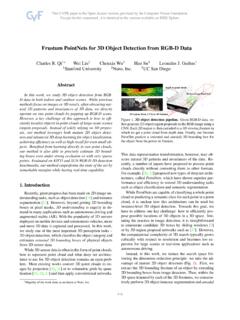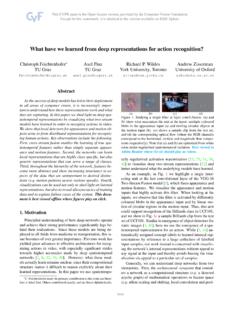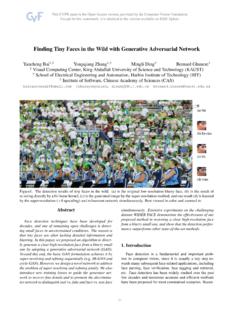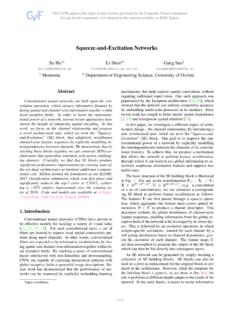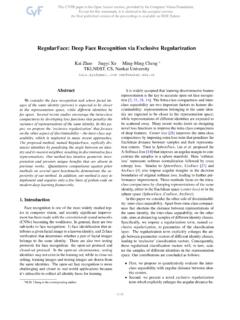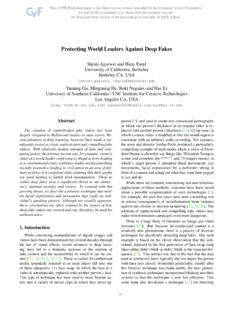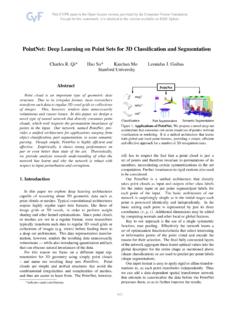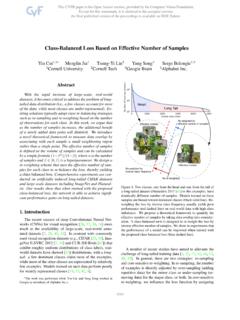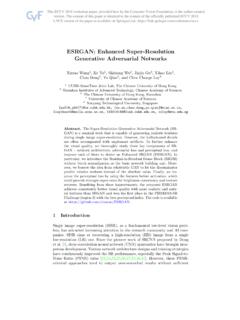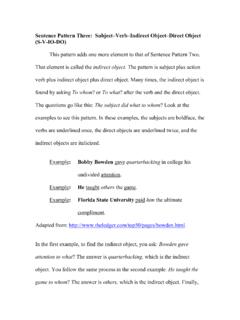Transcription of PointRCNN: 3D Object Proposal Generation and Detection ...
1 pointrcnn : 3d object proposal generation and detection from Point CloudShaoshuai Shi Xiaogang Wang Hongsheng LiThe Chinese University of Hong Kong{ssshi, xgwang, this paper, we propose pointrcnn for 3D Object de-tection from raw point cloud. The whole framework iscomposed of two stages: stage-1 for the bottom-up 3 Dproposal Generation and stage-2 for refining proposals inthe canonical coordinates to obtain the final Detection re-sults. Instead of generating proposals from RGB imageor projecting point cloud to bird s view or voxels as pre-vious methods do, our stage-1 sub-network directly gen-erates a small number of high-quality 3D proposals frompoint cloud in a bottom-up manner via segmenting the pointcloud of the whole scene into foreground points and back-ground.}
2 The stage-2 sub-network transforms the pooledpoints of each Proposal to canonical coordinates to learnbetter local spatial features, which is combined with globalsemantic features of each point learned in stage-1 for ac-curate box refinement and confidence prediction. Exten-sive experiments on the 3D Detection benchmark of KITTI dataset show that our proposed architecture outperformsstate-of-the-art methods with remarkable margins by us-ing only point cloud as input. The code is available IntroductionDeep learning has achieved remarkable progress on 2 Dcomputer vision tasks, including Object Detection [8, 32, 16]and instance segmentation [6, 10, 20], etc. Beyond 2 Dscene understanding, 3D Object Detection is crucial and in-dispensable for many real-world applications, such as au-tonomous driving and domestic robots.
3 While recent devel-oped 2D Detection algorithms are capable of handling largevariations of viewpoints and background clutters in images,the Detection of 3D objects with point clouds still faces greatchallenges from the irregular data format and large searchspace of 6 Degrees-of-Freedom (DoF) of 3D autonomous driving, the most commonly used 3 Dsensors are the LiDAR sensors, which generate 3D pointclouds to capture the 3D structures of the scenes. The dif-ficulty of point cloud-based 3D Object Detection mainly liesin irregularity of the point clouds. State-of-the-art 3D de-3D box estimationregiontofrustum2D image detector2D RoIspoint cloudpoint cloud in frustum3D anchorsfront viewprojection & poolingbird view projection & poolingfusionfront viewprojection & poolingbird viewprojection & pooling2D CNN2D CNN3D RoIsfusioncanonical 3D box refinementpoint cloud networkpoint cloud RoI poolingpoint cloudsegmentation3D Proposal generationpoint-wise feature vectorbottom-up 3D Proposal generationPoint cloudBird s viewRGB imageRGB image3D Box Predictions3D Box Predictions3D Box Predictionsb: Frustum-Pointneta: Aggregate View Object Detection (AVOD)c: Our approach ( pointrcnn ).
4 Figure 1. Comparison with state-of-the-art methods. Instead ofgenerating proposals from fused feature maps of bird s view andfront view [14], or RGB images [25], our method directly gener-ates 3D proposals from raw point cloud in a bottom-up methods either leverage the mature 2D detectionframeworks by projecting the point clouds into bird s view[14, 42, 17] (see Fig. 1 (a)), to the frontal view [4, 38], orto the regular 3D voxels [34, 43], which are not optimal andsuffer from information loss during the of transforming point cloud to voxels or otherregular data structures for feature learning, Qiet al. [26, 28]proposed PointNet for learning 3D representations directlyfrom point cloud data for point cloud classification and seg-mentation.
5 As shown in Fig. 1 (b), their follow-up work [25]applied PointNet in 3D Object Detection to estimate the 3 Dbounding boxes based on the cropped frustum point cloudfrom the 2D RGB Detection results. However, the perfor-mance of the method heavily relies on the 2D Detection per-formance and cannot take the advantages of 3D informationfor generating robust bounding box Object Detection from 2D images, 3D objects inautonomous driving scenes are naturally and well separated770by annotated 3D bounding boxes. In other words, the train-ing data for 3D Object Detection directly provides the se-mantic masks for 3D Object segmentation. This is a keydifference between 3D Detection and 2D Detection trainingdata.
6 In 2D Object Detection , the bounding boxes could onlyprovide weak supervisions for semantic segmentation [5].Based on this observation, we present a novel two-stage3D Object Detection framework, named pointrcnn , whichdirectly operates on 3D point clouds and achieves robustand accurate 3D Detection performance (see Fig. 1 (c)). Theproposed framework consists of two stages, the first stageaims at generating 3D bounding box Proposal in a bottom-up scheme. By utilizing 3D bounding boxes to generateground-truth segmentation mask, the first stage segmentsforeground points and generates a small number of bound-ing box proposals from the segmented points simultane-ously. Such a strategy avoids using the large number of 3 Danchor boxes in the whole 3D space as previous methods[43, 14, 4] do and saves much second stage of pointrcnn conducts canonical 3 Dbox refinement.
7 After the 3D proposals are generated, apoint cloud region pooling operation is adopted to poollearned point representations from stage-1. Unlike existing3D methods that directly estimate the global box coordi-nates, the pooled 3D points are transformed to the canoni-cal coordinates and combined with the pooled point featuresas well as the segmentation mask from stage-1 for learningrelative coordinate refinement. This strategy fully utilizesall information provided by our robust stage-1 segmentationand Proposal sub-network. To learn more effective coordi-nate refinements, we also propose the full bin-based 3D boxregression loss for Proposal Generation and refinement, andthe ablation experiments show that it converges faster andachieves higher recall than other 3D box regression contributions could be summarized into three-fold.
8 (1) We propose a novel bottom-up point cloud-based 3 Dbounding box Proposal Generation algorithm, which gener-ates a small number of high-quality 3D proposals via seg-menting the point cloud into foreground objects and back-ground. The learned point representation from segmenta-tion is not only good at Proposal Generation but is also help-ful for the later box refinement. (2) The proposed canonical3D bounding box refinement takes advantages of our high-recall box proposals generated from stage-1 and learns topredict box coordinates refinements in the canonical coor-dinates with robust bin-based losses. (3) Our proposed 3 Ddetection framework pointrcnn outperforms state-of-the-art methods with remarkable margins and ranks first amongall published works as of Nov.
9 16 2018 on the 3D detectiontest board of KITTI by using only point clouds as Related Work3D Object Detection from 2D are exist-ing works on estimating the 3D bounding box from images.[24, 15] leveraged the geometry constraints between 3D and2D bounding box to recover the 3D Object pose. [1, 44, 23]exploited the similarity between 3D objects and the CADmodels. Chenet al. [2, 3] formulated the 3D geometric in-formation of objects as an energy function to score the pre-defined 3D boxes. These works can only generate coarse3D Detection results due to the lack of depth informationand can be substantially affected by appearance Object Detection from point Object Detection methods proposed various ways to learndiscriminative features from the sparse 3D point clouds.
10 [4, 14, 42, 17, 41] projected point cloud to bird s viewand utilized 2D CNN to learn the point cloud features for3D box Generation . Songet al. [34] and Zhouet al. [43]grouped the points into voxels and used 3D CNN to learnthe features of voxels to generate 3D boxes. However, thebird s view projection and voxelization suffer from infor-mation loss due to the data quantization, and the 3D CNN isboth memory and computation inefficient. [25, 39] utilizedmature 2D detectors to generate 2D proposals from imagesand reduced the size of 3D points in each cropped imageregions. PointNet [26, 28] is then used to learn the pointcloud features for 3D box estimation. But the 2D image-based Proposal Generation might fail on some challengingcases that could only be well observed from 3D space.
